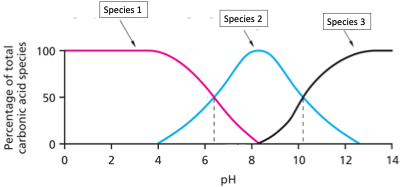Provide the chemical formulas and the names of the three predominant carbonic acid species indicated by arrows in the image below: Species 1 species 2 Species 3 Explain i) how you can determine the pH range at which a weak acid/conjugate base system will display buffering properties.ii) what is the reason/logic behind the rule applied in i)? and iii) indicate the pH ranges of the carbonic acid system based on the pka values provided above. Provide the chemical equilibrium that describes the carbonic acid buffer system that exists at pH 9.3. Clearly indicate the chemical formulas, identify the weak acid and it’s conjugate base, and the names of the chemical compounds.
Provide the chemical formulas and the names of the three predominant carbonic acid species indicated by arrows in the image below: Species 1 species 2 Species 3 Explain i) how you can determine the pH range at which a weak acid/conjugate base system will display buffering properties.ii) what is the reason/logic behind the rule applied in i)? and iii) indicate the pH ranges of the carbonic acid system based on the pka values provided above. Provide the chemical equilibrium that describes the carbonic acid buffer system that exists at pH 9.3. Clearly indicate the chemical formulas, identify the weak acid and it’s conjugate base, and the names of the chemical compounds.
Chemistry for Today: General, Organic, and Biochemistry
9th Edition
ISBN:9781305960060
Author:Spencer L. Seager, Michael R. Slabaugh, Maren S. Hansen
Publisher:Spencer L. Seager, Michael R. Slabaugh, Maren S. Hansen
Chapter15: Carboxylic Acids And Esters
Section: Chapter Questions
Problem 15.66E
Related questions
Question
Provide the chemical formulas and the names of the three predominant carbonic acid species indicated by arrows in the image below:
Species 1
species 2
Species 3
Explain i) how you can determine the pH range at which a weak acid/conjugate base system will display buffering properties.ii) what is the reason/logic behind the rule applied in i)? and iii) indicate the pH ranges of the carbonic acid system based on the pka values provided above.
Provide the

Transcribed Image Text:Percentage of total
carbonic acid species
100
50
0
2
4
6
Species 2
pH
8
10
Species 3
12
14
Expert Solution
This question has been solved!
Explore an expertly crafted, step-by-step solution for a thorough understanding of key concepts.
This is a popular solution!
Trending now
This is a popular solution!
Step by step
Solved in 2 steps

Knowledge Booster
Learn more about
Need a deep-dive on the concept behind this application? Look no further. Learn more about this topic, chemistry and related others by exploring similar questions and additional content below.Recommended textbooks for you

Chemistry for Today: General, Organic, and Bioche…
Chemistry
ISBN:
9781305960060
Author:
Spencer L. Seager, Michael R. Slabaugh, Maren S. Hansen
Publisher:
Cengage Learning

Introductory Chemistry: A Foundation
Chemistry
ISBN:
9781337399425
Author:
Steven S. Zumdahl, Donald J. DeCoste
Publisher:
Cengage Learning

Chemistry: Matter and Change
Chemistry
ISBN:
9780078746376
Author:
Dinah Zike, Laurel Dingrando, Nicholas Hainen, Cheryl Wistrom
Publisher:
Glencoe/McGraw-Hill School Pub Co

Chemistry for Today: General, Organic, and Bioche…
Chemistry
ISBN:
9781305960060
Author:
Spencer L. Seager, Michael R. Slabaugh, Maren S. Hansen
Publisher:
Cengage Learning

Introductory Chemistry: A Foundation
Chemistry
ISBN:
9781337399425
Author:
Steven S. Zumdahl, Donald J. DeCoste
Publisher:
Cengage Learning

Chemistry: Matter and Change
Chemistry
ISBN:
9780078746376
Author:
Dinah Zike, Laurel Dingrando, Nicholas Hainen, Cheryl Wistrom
Publisher:
Glencoe/McGraw-Hill School Pub Co

Chemistry: The Molecular Science
Chemistry
ISBN:
9781285199047
Author:
John W. Moore, Conrad L. Stanitski
Publisher:
Cengage Learning

Introduction to General, Organic and Biochemistry
Chemistry
ISBN:
9781285869759
Author:
Frederick A. Bettelheim, William H. Brown, Mary K. Campbell, Shawn O. Farrell, Omar Torres
Publisher:
Cengage Learning

Chemistry & Chemical Reactivity
Chemistry
ISBN:
9781337399074
Author:
John C. Kotz, Paul M. Treichel, John Townsend, David Treichel
Publisher:
Cengage Learning